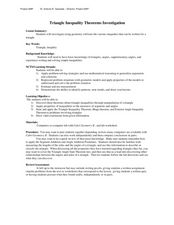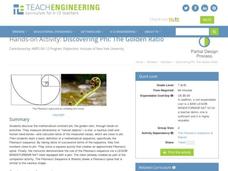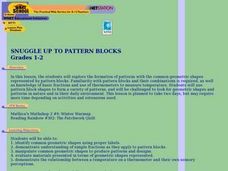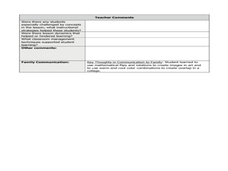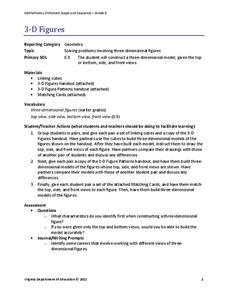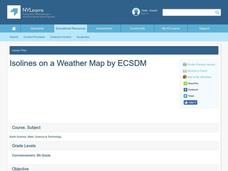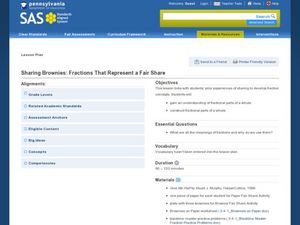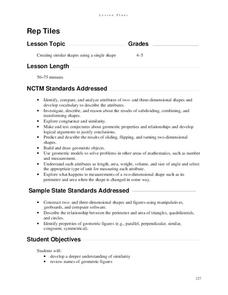Curated OER
Digital Statistics
Research data analysis by creating charts in class. Define the differences between an "average" and "range" while examining measurement data based on student height. Utilize computer software to create a height graph which is shared with...
Curated OER
Triangle Inequality Theorems Investigation
Students estimate and measure triangles. In this geometry lesson, students identify the relationship between three sides and a triangle. They use the inequality theorem to decide if a triangle will be formed or not.
Curated OER
Arithmetic Sequences
Find the sequence of an equation with your math super stars. They differentiate between arithmetic and geometric sequences and then calculate the sum of finite and infinite sequences.
Teach Engineering
Discovering Phi: The Golden Ratio
Fe, phi, fo, fum. This activity leads pairs to find the ratio of consecutive terms of the Fibonacci sequence. The pairs find that the Fibonacci sequence can be found in many places. A discussion with the class shows that the ratios...
Curated OER
Rotations in the Plane
Pupils investigate the properties of a rotation as they use technology (Cabri, Jr.) to observe the relationship between the pre-image and the image formed by the rotation. The lesson provides ample opportunity for learners to conjecture...
Curated OER
Rocket Patterns
Students create their own paper rockets. They identify different patterns and practice making their own. They also discover the concept of sequences.
Curated OER
Math Quilts
Students examine geometric shapes. In this geometric shape lesson plan, students examine how geometric shapes flip, turn, and slide to create a pattern. Students analyze the role that quilts played in helping slaves escape to freedom. ...
Curated OER
Snuggle Up To Pattern Blocks
Young scholars view and discuss a video about the use of pattern block shapes to form pictures. They, in groups, form garden and quilt designs using pattern blocks and then decorate the room with their art.
Curated OER
Shape Patterns
In this math worksheet, students examine a pattern of geometric shapes. After looking at the sequence of shapes and deciding what the pattern is, students choose the shape that would come next. There are 4 problems.
Curated OER
Pattern Recognition
Young scholars identify different patterns and sequence in a deck of cards. For this algebra lesson, students use reasoning and proof to solve problems. They create different steps to identify and solve their problems.
Curated OER
It's All in the Rings
Students examine how the environment influences tree growth. In this tree lesson, students analyze the growth of rings to see how plants adjust to adverse conditions in order to survive.
Curated OER
Range, Cluster, Gap and Outliers
There are a number of activities here where learners collect and record data, as well as, activities where the likelihood of an event happening is calculated given the experimental probability. Young statisticians organize information...
Pyro Innovations
Get into Shape
Shapes are so fun! Little ones explore, identify, and create shapes using tangrams or pattern blocks. The activity is intended to stimulate critical thinking while engaging learners through play and shape identification. Each child will...
Curated OER
Geometric Collages
Fourth graders investigate the concept of geometric patterning. They create their own patterns with a few basic requirements. The patterns must illustrate the concepts of flipping, 90 and 180 degree rotations. The collages also consist...
Curated OER
Tiling the Classroom
Learners see how to identify regular polygons, how to slide, turn and flip polygons, and why certain polygons tessellate better than others. Groups create a one foot square design to be used to tile the classroom. Great lesson!
Virginia Department of Education
3-D Figures
Scholars construct three-dimensional figures to study dimension and side views. Learners build models using linking cubes to match views of different sides. After practicing with models, they attempt to match three-dimensional drawings...
Curated OER
Shape Collages
To reinforce shape recognition and identification, little learners create a shape collage. They name each shape as they go, gluing or pasting them onto bright paper. They discuss collage techniques and are encouraged to use their shapes...
Curated OER
Fair Shares and Geometric Spirals
Young scholars tackle the problem of how to divide a triangular piece of land fairly among four people. They decide whether their method of fair division always works or if it only works in special cases.
Curated OER
Isolines on a Weather Map
Ninth graders recognize isolines on a weather map and draw isolines based on temperature data on a weather map. They draw isotherms on a weather map to identify temperature patterns.
Curated OER
Profitable Soda Stand
Am I making any money? Help learners determine if their fictitious soda stand is turning a profit. They graph linear equations using the slope and y-intercept and identify the best price to use to sell soda. They identify the domain and...
Curated OER
Global Warming
A series of independent learning activities teaches learners about global warming as it relates to economics and industrialization. The culminating project requires them to create a multimedia presentation identifying the problems,...
Curated OER
Sharing Brownies: Fractions That Represent a Fair Share
Elementary graders discover the concept of fractional pieces of a whole. They investigate the meanings of fractions in everyday life and why they are used. Pupils divide brownies amongst each other to demonstrate the use of fractions...
Improving Measurement and Geometry in Elementary Schools
Rep Tiles
In addition to the catchy title, this lesson plan provides upper graders an opportunity to more closely scrutinize the attributes of plane figures. In particular, they focus on the similarity of different shapes. Both whole-class and...
Curated OER
Exponential Expressions - Perfect Squares, Square Roots
Color tiles are used to model perfect squares. Alone or in pairs, middle schoolers will find patterns. Afterward, the relationship between perfect squares and roots will be discussed as a whole class.

